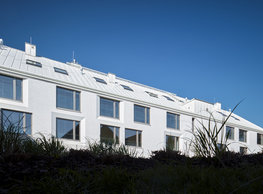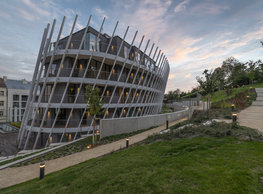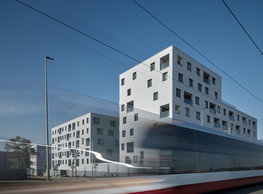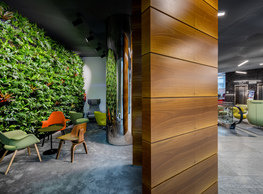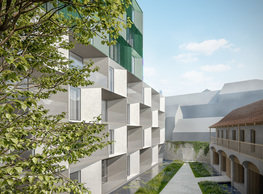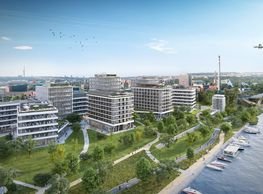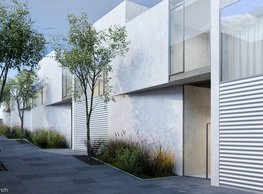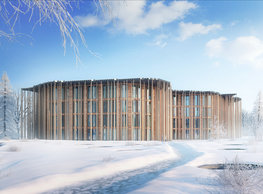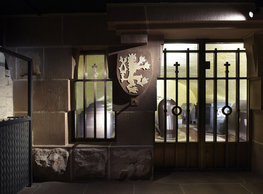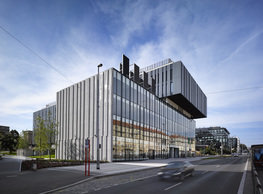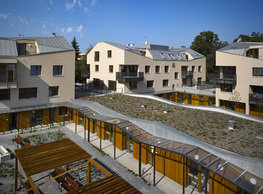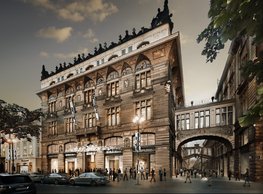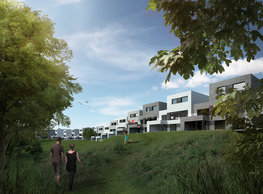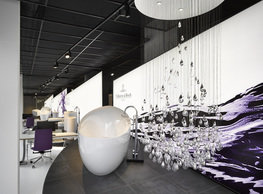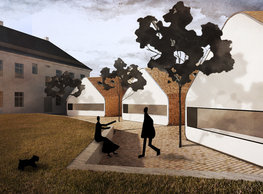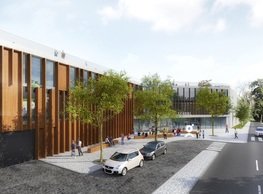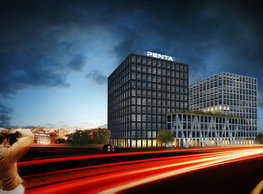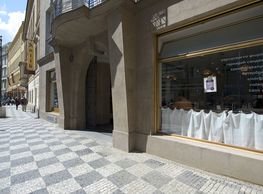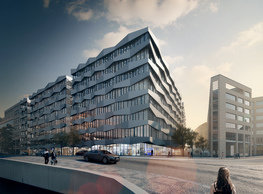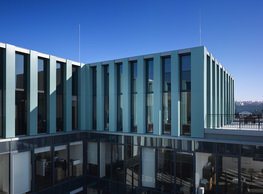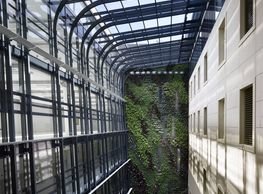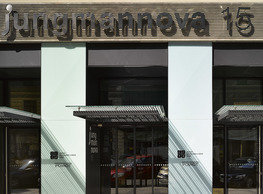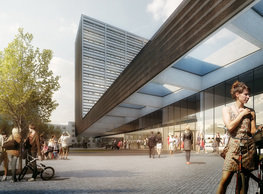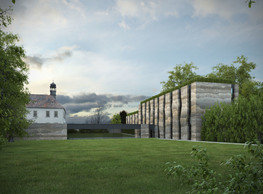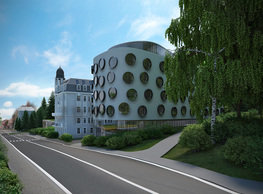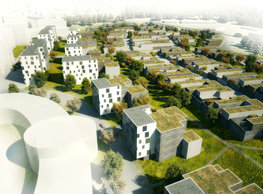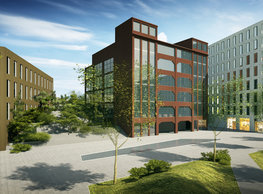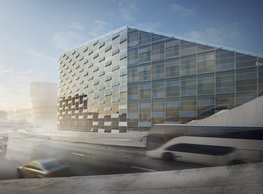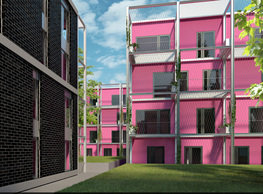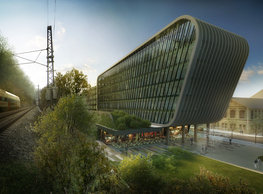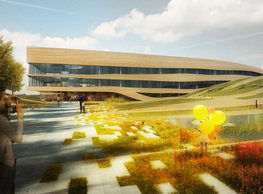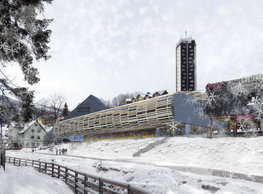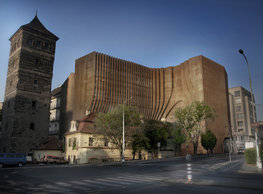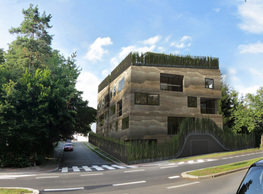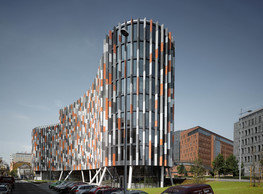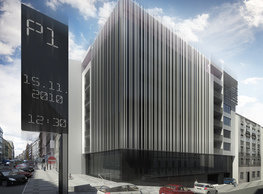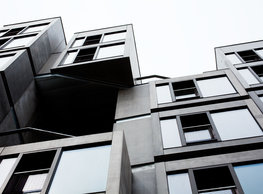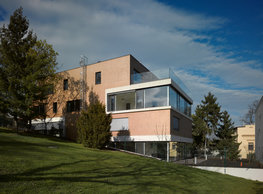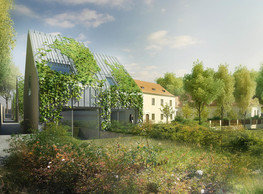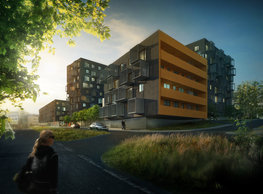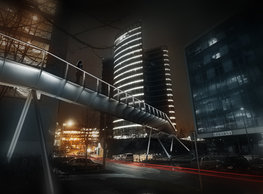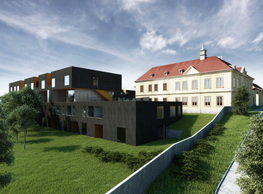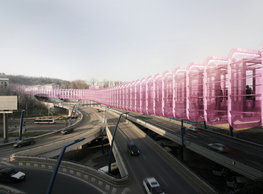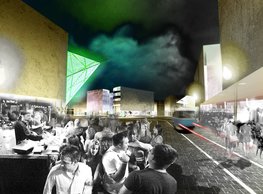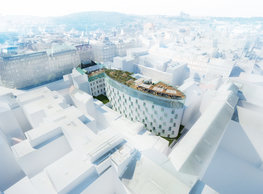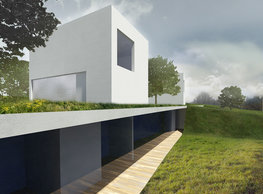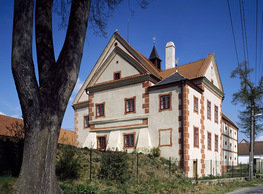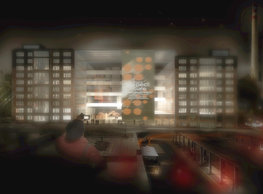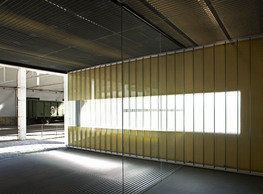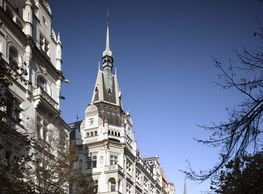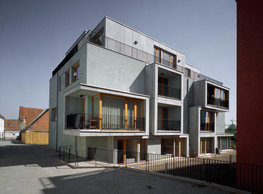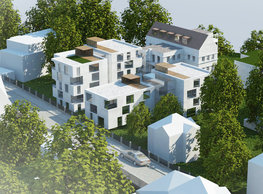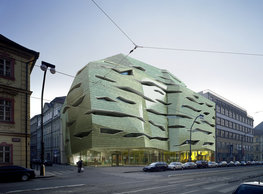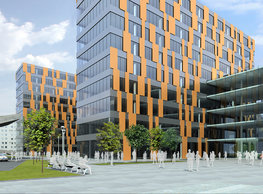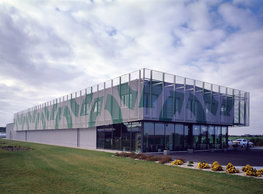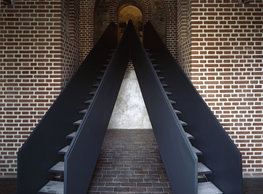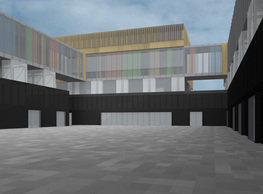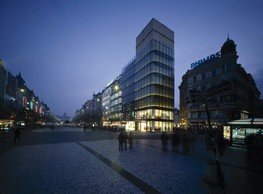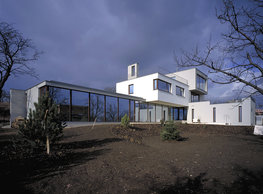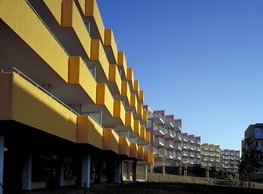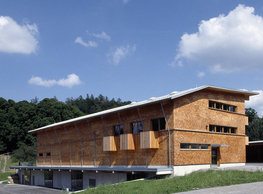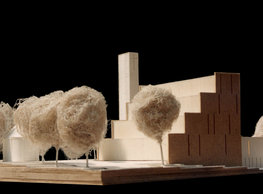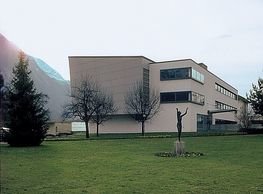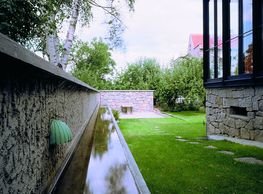The renowned hotel at the upper part of the Wenceslas Square developed from two town houses, originally related to horse-trading that used to be performed at the square. Since 1844, both houses had one owner, Vilém Hauser, who ran a hotel here. In 1903, the houses were altered at large. A spacious coffee shop was planned behind the front face of the new hotel together with a large new dining room in the so-far undeveloped part of the courtyard between the inner wings. The project was carried out by architect Bělský; Bedřich Bendelmayer, professor Ohman’s disciple, developed the drawings. The first project planned to demolish the front building and a greater part of the right and left wing including the foundation. A new four-storied Art Nouveau hotel was erected on the site this way acquired. The building contained a restaurant, a coffee shop, and other functionally related rooms on the ground floor and the mezzanine, and in a part of the cellar. Guest rooms and hotel facilities were accommodated on the remaining stories. To fit in this rather complex program, the architect designed a deep main building. He solved the associated problems of sufficient daylighting of all areas by placing elliptical openings in the ceiling of the coffee shop and the vestibule in front of the dining room (currently the French Restaurant) and glass roofs above the central atrium, the staircase, and the dining room. In 1904, demolishing started and then laying bricks for new foundations. Several alterations were done to the project during construction regarding the hotel operation and the structure: masonry pillars were replaced by metal ones. The main building was certified for use in 1905. More alterations were carried out from 1924 to 1948. The hotel called GRANDHOTEL ŠROUBEK was owned by Karel Šroubek in this period. These alterations regarded mostly hotel interior equipment and additional sanitary facilities and toilets in guest and staff rooms. The hotel was socialised in 1948, and it was connected to the next MERAN-GARNI hotel no. 825 the next year. That meant just breaking connecting openings between the two buildings. Both hotels adopted the name EVROPA in 1951. This connection was cancelled in 1989, and the former ŠROUBEK hotel retained the name HOTEL EVROPA. New building The addition in the courtyard is elliptical. The shape builds on the proportions of the site and its optimal use; its longitudinal SW-NE axis is perpendicular to the Wenceslas Square. The elliptic block has seven aboveground stories (that is, in fact, nine storeys with construction heights lower than the historic building) and two basements. It partly stems from the rectangular base and green areas establishing the ground floor and the mezzanine; on higher storeys, it is free and appropriately distant from the original Art Nouveau building. The old and the new part are connected on the ground floor and the mezzanine. Inspired by the Art Nouveau order used in the historic building, we designed a central elliptical atrium (similar to the oval gallery of the famous coffee shop in the old building) running through the entire new block from the top down to the first basement. Its roof is glazed letting daylight into the hotel layout the corridors – galleries – and staircase flights connecting hotel storeys. The two top storeys of the new block step back in the north part to provide daylight and sunlight to the neighbouring buildings. These areas stepping back are used as a sundeck to the swimming pool on the seventh floor and loggias to guestrooms on the sixth floor. Facades The Art Nouveau façade to the square is preserved in its original form. Its elements and decorative elements are thoroughly restored (the same as the other historical parts of the hotel) by speciality firms licensed by the Ministry of Culture. The new façade was designed in two alternatives. As glazed (sub-alternatively with a large serigraphy of a motive by Alphonse Mucha in golden summer colour) and as a standard one with a fenestration pattern (alternating large and small windows) establishing almost dynamical diagonals supporting the oval shape of the ellipse on the façade when seen from afar. Function The historic building remains unchanged in its essential functions. The greater part contains guestrooms (43 rooms) connected to the central staircase with the original atrium. They are carefully restored with much attention paid to their original character and interiors including details and materials. The accommodation function, aside from standard back-of-house facilities (shop/concierge, offices, staff break-out rooms), is complemented by several new ones. There is an Art Nouveau coffee shop on the ground floor and the mezzanine, the French Restaurant; lobbies; a self-service restaurant – the JARMARK type (with integrated valued elements of the original interior equipment of the current Pilsen restaurant and adjacent rooms). A kitchen and a night club are in the second basement in the place of the existing coal-burning boiler plant and storage (this technology was relocated to the new building’s basement) and a separate escape staircase in the current supply corridor and the platform to the Wenceslas Square. A couple of original lifts and a new supply/evacuation lift connect the floors. The main reception with the lobby was relocated from the currently very busy entrance area to southern position next to the French Restaurant on the border between the old and the new part. It is possible to walk through the reception hall to the new block with a spacious lobby equipped with lounge furniture and a bar connected to the to the breakfast room in the north part of the ellipse. This space is fitted with doors that can open to the outdoor garden to which it is visually connected via a glazed façade of the ground floor. Aside from 114 guestrooms, the new block contains building technology rooms and a car park (with a car lift from the street; 16 parking places) in the second basement; a full range of storage and prep rooms; a gas-burning boiler room, and other facilities (staff lockers). There are congress halls in the first basement (one large and six smaller meeting rooms of the total maximum capacity 315 persons) connected to the ground floor and other floors by three lifts, a staircase in the elliptical atrium, and a separate exit stairway up to the ground. A hotel gym, a swimming pool with a bar, a dry and steam sauna and visitor lockers with showers, and a relaxation room are designed on the seventh floor. A terrace can be accessed from here fitted with deck chairs with beautiful views of the surroundings.
portfolio
![]()
monastery of st. gabriel
![]()
nová zbrojovka block g
![]()
nad krocínkou a
![]()
nad krocínkou b
![]()
dobřichovice farmstead
![]()
nymburk train station
![]()
stará boleslav primary school
![]()
holečkova 26 residence
![]()
komořany elementary school
![]()
kindergarten jeseniova
![]()
nová elektra residence
![]()
filadelfie bldg. – the new reception
![]()
písnice elementary school
![]()
bytové domy vítězná/újezd
![]()
afi vokovice
![]()
showroom elite bath/bulthaup sk
![]()
port 7
![]()
main point pankrác
![]()
oktáva houses
![]()
lesy čr headquarters
![]()
royal tomb
![]()
the blox
![]()
dob centre in dobřichovice
![]()
contemporary glass muzeum
![]()
pod hády brno
![]()
elite bath showroom karlín
![]()
communal flats in dolní břežany
![]()
šantovka residence
![]()
open gate II
![]()
ružinov office building
![]()
dlouhá palace
![]()
vinohradská 8
![]()
masarykovo railway station
![]()
retail and office development
![]()
jindřišská 16
![]()
jungmannova 15
![]()
regina hradec králové
![]()
chateau dolní břežany
![]()
the metropole hotel in mariánské lázně (marienbad)
![]()
waltrovka
![]()
square mechanica
![]()
porto mercandini
![]()
plzeňská 18
![]()
vrchlického residence
![]()
karlín railway
![]()
science research centre
![]()
sněžka apartment house
![]()
novomlýnská brána
![]()
jeremenkova residence
![]()
main point karlin
![]()
flat b3 prague
![]()
štěpánská 47
![]()
tenement house with a gym
![]()
švédská residence
![]()
hendlův dvůr
![]()
klamovka residential complex
![]()
botanica vidoule phase 6
![]()
footbridge in bb centre
![]()
perníkářka manor
![]()
municipal interventions prague 2010
![]()
černá louka ostrava
![]()
evropa hotel
![]()
bb centrum filadelfie
![]()
family houses in radotín
![]()
cherubín II
![]()
fc bohemians praha 1905
![]()
ostrolovský újezd chateau
![]()
zlín cultural centre
![]()
znojemská hospice
![]()
pilsner urquell
![]()
st. wenceslas exposition
![]()
institute of noblewomen
![]()
karlov office building
![]()
cherub I
![]()
pařížská 9
![]()
jinonice villa park
![]()
petynka hotel
![]()
sanopz residential complex
![]()
viktoria center pankrác
![]()
hotel crystal palace
![]()
invalidovna offices
![]()
performing arts center seoul
![]()
boscolo carlo IV hotel
![]()
toner recycling company building
![]()
the story of prague castle
![]()
umprum in prague-ďáblice
![]()
mrázovka apartment villa
![]()
school gym in prague-troja
![]()
roma hotel
![]()
euro palace
![]()
ten centuries of architecture
![]()
villa třešňovka
![]()
velká skála
![]()
sternberg palace prague castle
![]()
st. nicholas church in čečovice
![]()
olga and václav havel's villa
![]()
tierpark langenberg
![]()
a church in neratovice
![]()
school centre interlaken
![]()
forestry school in lyss
![]()
villa dobeška
![]()
tuscany in maps




